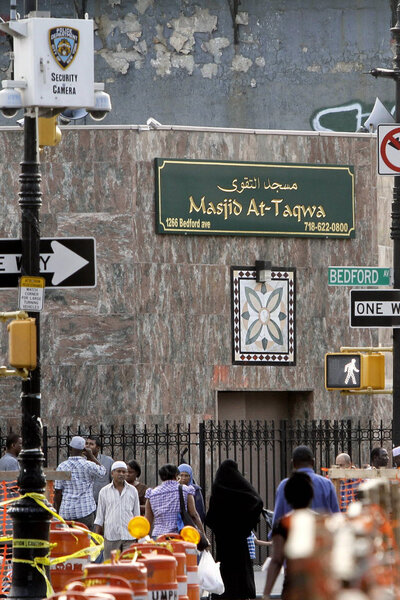NYPD faces prospect of 2 outside monitors
Loading...
| New York
After years of burnishing a reputation as one of the nation's most potent police forces, the New York Police Department appears poised to become one of the most closely monitored.
A federal judge this week said the department made thousands of racially discriminatory street stops and appointed a monitor to direct changes. And city lawmakers are readying for a final vote Thursday on creating an inspector general for the NYPD and widening the legal path for pursuing claims of police bias.
It's a one-two punch of outside tinkering that will muddy police work, a pair of complementary steps to protect civil rights or a rash of policymaking that may end up meaning little on the street, depending on who gets asked. But from any perspective, it would be the onset of a new era of oversight for the country's biggest police department, though the impacts would be defined by particulars and politics still in play.
The federal ruling outlines but doesn't always detail reforms, and the city plans to appeal it. The City Council, if it succeeds in overriding a mayoral veto, would establish a monitor but not select the person or specify exactly what gets investigated. And a new mayor will take office next year, which could well mean new police leadership.
"The complexity, at this point, is that there are so many moving parts," said John Jay College of Criminal Justice professor Eugene O'Donnell, who isn't involved in the litigation or legislation. "And it doesn't help that it became very adversarial."
Some other police forces, including the Los Angeles Police Department, also have had both court monitoring and an inspector general. The NYPD was under a 1980s federal consent decree that involved undercover and surveillance techniques, but this would be an unprecedented level of outside scrutiny for the agency.
Advocates see distinct roles for each of the prospective new NYPD watchdogs, who would have different scopes and powers. They wouldn't directly intersect, deriving their authority from different parts of government.
The court monitor could compel changes, via the judge, but only concerning stop and frisk. If the ruling stands after the expected appeal, the monitor will flesh out details of U.S. District Court Judge Shira Scheindlin's calls for changes to officer training, supervision and discipline. The monitor also would keep tabs on specific initiatives Scheindlin required: revising forms that document stops and testing body-worn cameras for officers.
The inspector general could look at many aspects of policing — surveillance of Muslims or officers' response to the mentally ill, for instance. But the inspector could issue only recommendations, not orders, though the mayor or council could make them mandatory.
The court's monitoring would end when the judge saw no further need for it, while the inspector general's position would be permanent.
"Both are essential elements in creating transparency and accountability in the NYPD," said Chauniqua Young of the Center for Constitutional Rights, which brought the federal case and is among groups backing the city legislation.
But Mayor Michael Bloomberg and Police Commissioner Raymond Kelly have bitterly resisted the push to impose more outside input on the NYPD, pressure that built amid anger over the department's heavy use of the stop and frisk tactic and concerns about extensive NYPD surveillance of Muslims. The spying was disclosed in stories by The Associated Press.
The mayor and commissioner say police already get plenty of scrutiny from entities ranging from a 700-person internal investigations staff to a civilian complaint board. The new monitors would layer on confusing, overlapping oversight, the officials say.
Bloomberg has raised the specter of the police force becoming so policed by watchdogs and lawsuits that officers might hesitate to defend themselves, with deadly consequences.
"I'd like to see you go to the funeral and explain to the family," he snapped at a news conference Monday.
Kelly decried the court ruling during news show appearances Sunday; the judge has "indicted an entire police department... based on what we believe is very flimsy information," he said on CBS' "Face the Nation."
Supporters hope Scheindlin's ruling will embolden lawmakers to back what could be an extremely close veto override vote Thursday; sponsors expect it to succeed. Bloomberg, meanwhile, suggested Scheindlin's ruling should give lawmakers pause about adding more monitoring.
The legislation also would make it easier to bring suits claiming discriminatory policing — cases like the one Scheindlin decided. She found police systematically and unjustly singled out black and Hispanic men for stop and frisks, about 90 percent of which don't result in arrests or tickets.
The legislation would apply only in state court, easing some legal standards the advocates faced in the federal case, City Councilman Brad Lander said.
To some, the question isn't whether to add the new watchdogs, but how much they could accomplish.
Police Sgt. Ed Mullins sees the inspector general as a bureaucratic add-on and the court monitor as "an easy way out for a judge." Changing the dynamic between police and minority communities takes more than "coming in here and saying, 'You gotta do this,'" said Mullins, who leads the Sergeants Benevolent Association union.
In Harlem, Edgar Sanchez, 34, digested the idea of new NYPD monitors with something of a shrug.
"They'll still do whatever they want to do, and they'll use the excuse that they're protecting the people," he said. "The police will always have that freedom."
Associated Press writer Colleen Long contributed to this report. Follow Jennifer Peltz at http://twitter.com/jennpeltz







